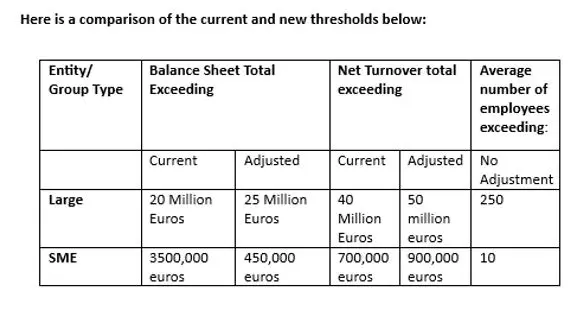

At the beginning of the year, the European Union adopted the Corporate Sustainability Directive (CSRD), which potentially required thousands of EU and non-EU companies to annually report on sustainability alongside their financial reporting. The company’s reporting obligation is determined by size, and most large EU companies and groups will need to comply for financial years beginning on or after January 1st, 2025. Certain small and medium sized enterprises will need to comply for financial years beginning or after January 1 202.
On October 17th, 2023, the EU Commissions adopted an amendment to the thresholds in the accounting directive, adjusting the entities who are responsible for filing CSRD reports. The reasoning behind the commission’s newly amended thresholds is to “accommodate for inflation over the past 10 years and to reduce the reporting burden for smaller companies.” The amendments adopted by the commission are now subject to a scrutiny period and if the changes are not vetoed the amendments will be formally published in the Official Journal of the European Union. These adjusted thresholds will be applied beginning January 1st, 2024, if confirmed.

To find out more about the CSRD read Mike Guilfoyle’s VP at ARCs blog, “EU Drives Transparency and Accountability Into Industrial Sustainability”
October was a busy month for the US federal government. The Department of Energy announced they selected the 7 clean energy hydrogen hubs that will be receiving up to $7 billion in support. The hubs are scattered across the nation from the West Coast to the East Coast. The members who are a part of the selected hubs include state governments, private companies, and research organizations. The $7 billion will be released only after each hub has met key design and viability milestones, garnering more than $40 billion in follow on investments from the companies involved. These selected hubs make up the majority of the 9.5 billion in hydrogen incentives authorized by the 2021 Bipartisan Infrastructure Law. The industries expected to use the hydrogen range from chemicals and fertilizer production to shipping, trucking and power generation, according to DOE officials.
The Department of Energy also announced a historic investment in the core infrastructure of the energy transition, the power grid. The announcement listed out the $3.5 billion in grants to expand capacity for wind and solar power, harden power lines against extreme weather, integrate batteries and electric vehicles, and build out microgrids that can withstand a power outage. The announcement also named 58 projects across 44 states that are eligible to receive federal funding. The Energy Secretary Jennifer Granholm called the announcement “the largest ever investment in Americas grid.”
The Chinese city of Shanghai’s municipal government has pledged to develop an offshore wind to hydrogen pilot project as part of its 2023-2026 work plan. The government will provide support for offshore wind projects that produce green hydrogen during “high fluctuation power output conditions”. Shanghai is the location of the first commercial-scale offshore wind farm in China, Donghai Bridge, which was installed in 2010. The Shanghai government in July issued a hydrogen mobility work plan up to 2025 which targeted 10,000 fuel cell electric vehicles (FCEVs) and at least 70 hydrogen refueling stations on its roads.
At the beginning of the month during the UNEP Forum of Ministers and Environment Authorities of Asia Pacific, senior officials pledged concerted action to tackle the crises of climate change. This conference took place in Sri Lanka addressing the cascading effects of climate change on the Pacific Island Countries. UNEP Deputy Executive Director, Elizabeth Mrema, said “Global cooperation and multilateral action are our only hope to avert the impending catastrophes, signs of which are all around us. The action of Member States and all stakeholders in the Asia-Pacific region will be critical to delivering for people and for planet.”

